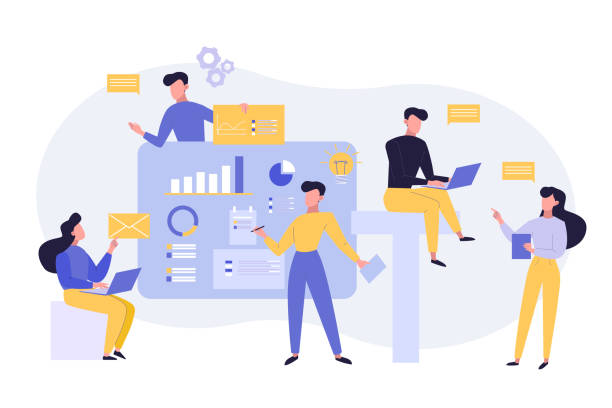Fundamentals of SEO-Optimized Website Design and its Importance
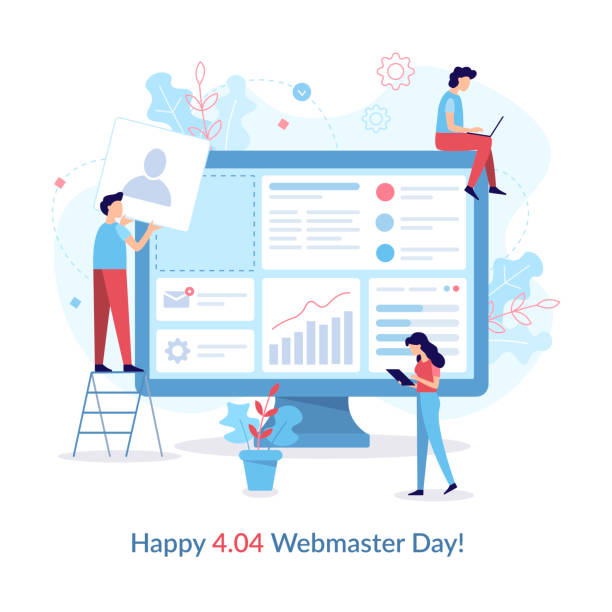
In today’s digital world, having a website without #SEO (Search Engine Optimization) is like having a store in the desert; no one finds it.
SEO-optimized website design not only refers to the visual appeal or technical performance of your website, but also ensures its visibility to search engines like Google.
This comprehensive process includes technical, content, and off-site optimizations to make your website appear higher in search results and attract more organic traffic.
The importance of this issue stems from the fact that a large portion of internet users rely on search engines to find the products, services, or information they need.
Therefore, if your website is not on the first pages of search results, you will effectively miss countless opportunities to attract potential customers.
The main goal of SEO-optimized website design is to improve your website’s ranking and increase its visibility in search results.
This not only leads to increased traffic but also boosts user trust and credibility in your brand.
From an expert perspective, SEO is a long-term investment with a significant return on investment, as organic traffic is free and sustainable.
A website optimized for search engines is not only more understandable for algorithms but also provides a better user experience.
As initial guidance, you should know that SEO must be considered from the very beginning of the website design process, not after its completion.
This comprehensive approach prevents wasted time and resources and paves the way for success.
Are you tired of your e-commerce site having visitors but no sales? Rasaweb solves your main problem with professional e-commerce website design!
✅ Significant sales increase with targeted design
✅ Flawless user experience for your customers
⚡ Get a free consultation!
Keyword Research, the Cornerstone of Website SEO

Keyword research is the backbone of any successful SEO-optimized website design strategy.
This analytical and specialized stage involves identifying phrases and words that users enter into search engines to find products, services, or information related to your business.
Without comprehensive and accurate keyword research, your website’s content may not properly reach its target audience, and all efforts for website optimization may be fruitless.
The keyword research process includes finding words with high search volume, suitable competition, and relevant user intent.
For example, are users looking for information (informational intent), do they intend to buy (commercial intent), or are they looking for a specific website (navigational intent)? The answer to these questions determines what type of content should be produced.
Various tools such as Google Keyword Planner, Ahrefs, Semrush, and Moz Keyword Explorer are available for this purpose, providing valuable data on search volume, competition, and related keywords.
An important educational point is that you shouldn’t only think about single-word keywords; longer keywords (long-tail keywords), despite having lower search volume, usually have a higher purchase intent and less competition.
Optimizing content for these keywords can drive highly targeted and valuable traffic to your website.
One of the thought-provoking questions in this area is whether we should always pursue keywords with the highest search volume? The answer is no, because high-volume keywords usually have very fierce competition, making it difficult to rank for them.
Instead, focusing on a combination of relevant keywords with moderate search volume and less competition can be a more effective strategy for an SEO-optimized website design.
Technical SEO in SEO-Optimized Website Design
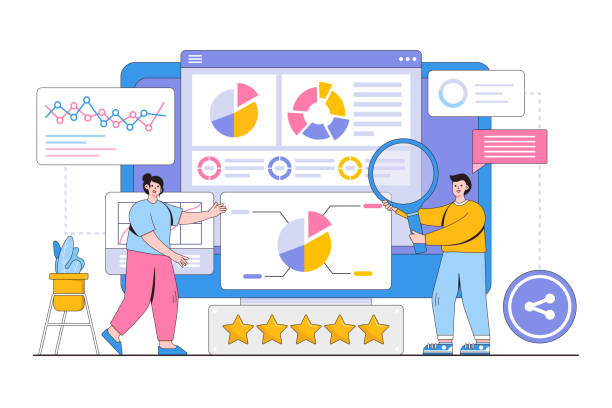
Technical optimization is a crucial aspect of SEO-optimized website design that helps improve your website’s infrastructure so search engine crawlers can find, crawl, and index it more effectively.
This specialized section includes items that do not directly affect user experience but are essential for SEO performance.
Among the most important aspects of Technical SEO are site structure, robots.txt file, XML sitemap, structured data (Schema Markup), user-friendly URLs, and fixing crawl errors.
Ensuring your website has a logical hierarchical structure helps search engines better understand your content.
The robots.txt file tells search engines which parts of the website to crawl and which to ignore, while the XML sitemap helps them discover all your important pages.
Structured Data like Schema Markup provides additional information to search engines that can lead to the display of Rich Snippets in search results and increase your click-through rate (CTR).
As a practical guide, continuous review of Google Search Console reports to identify and fix crawl errors and indexing issues is essential.
| Element | Description | SEO Importance |
|---|---|---|
| Site Structure | Logical organization of pages and content | Increased crawlability and thematic understanding |
| XML Sitemap | A file containing all important site URLs | Helps search engine discover pages |
| Robots.txt file | Controls crawler access to specific sections | Prevents crawling of unnecessary/duplicate content |
| Structured Data | Adding semantic information to content | Display of Rich Snippets and increased CTR |
Ensuring the presence of an SSL/HTTPS certificate is also essential for security and SEO, as Google prioritizes secure websites.
The explanation that can be given in this regard is that HTTPS not only encrypts user data but also provides a positive signal to search engines for better ranking.
Overall, the stronger and more flawless your website’s technical infrastructure, the easier it will be for search engines to understand and display your content to users, which is one of the main pillars of SEO-optimized website design.
Quality Content and its Role in SEO-Driven Website Design

Content is king; this statement holds true not only in digital marketing but also in the field of SEO-driven website design.
Producing high-quality and relevant content is one of the most powerful levers for improving SEO ranking and attracting target audiences.
Good content should not only meet user needs but also be optimized in a way that is understandable to search engines.
This means intelligently integrating researched keywords into text, titles, meta descriptions, and URLs, without sacrificing readability or content quality.
Your content should be educational, explanatory, and comprehensive, answering potential user questions.
For example, if you are designing an SEO-optimized website for an online shoe store, product page content should include detailed descriptions, benefits, customer reviews, and even articles on choosing the right shoe for different activities.
This approach not only engages users but also shows search engines that your website is a reliable and comprehensive resource in its field.
Quality content includes various formats: blog articles, product pages, service pages, infographics, videos, and podcasts.
Each of these formats can be optimized for SEO in different ways and meet various user needs.
From a newsworthy perspective, Google’s algorithms are constantly being updated to better identify useful and high-quality content.
This means that simply filling content with keywords is no longer enough; content must be valuable, unique, and engaging for users.
Have you ever wondered how you can also produce entertaining content that is both informative and SEO-friendly? Using storytelling, real-life examples, or even humorous comparisons can add to the appeal of your content.
Remember that the ultimate goal is to provide the best possible user experience, and this is what search engines value and rank your website for.
How much does losing business leads due to an unprofessional site cost you? Solve this problem permanently with professional corporate website design by Rasaweb!
✅ Increased credibility and trust of potential customers
✅ Easier attraction of new business leads
⚡ Get a free consultation now!
User Experience (UX) and its Connection to Website SEO

User Experience (UX) and SEO are two sides of the same coin that play a vital role in SEO-optimized website design.
In the past, SEO focused more on technical aspects and keywords, but today, Google and other search engines are increasingly valuing user experience signals.
An excellent user experience not only satisfies users but also indirectly affects SEO ranking.
Signals such as low bounce rate, high dwell time on the page, number of pages visited per session, and click-through rate (CTR) in search results are all monitored by search engines and indicate the quality of the user experience.
A website with complex navigation, slow loading speed, or non-responsive design quickly loses its users, and these negative signals harm its SEO ranking.
As a precise analysis, Google further emphasized the importance of user experience by introducing Core Web Vitals.
These metrics (such as LCP, FID, CLS) directly measure page loading time, interactivity, and visual stability.
A key guidance for improving UX and, consequently, SEO, is to view your website from the user’s perspective.
Is information easy to find? Are forms easy to fill out? Is the visual design attractive and distraction-free?
A thought-provoking question in this area is whether it is possible to have a website with excellent SEO but poor UX? Probably not, or at least not for long.
Search engines are becoming increasingly smarter and can understand user behavior.
If users quickly leave your site after entering it, Google realizes that your site did not meet their needs and lowers your ranking.
Therefore, investing in improving UX means directly investing in your site’s SEO and is an integral part of SEO-optimized website design.
Internal and External Link Building to Increase Site Authority
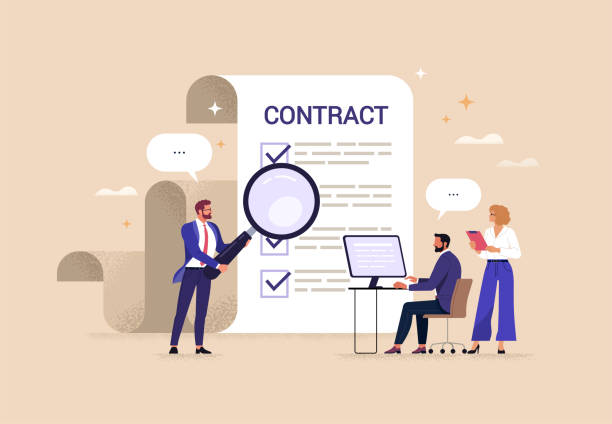
Link building, both internal and external, is another backbone in the strategy of SEO-optimized website design that helps increase your website’s authority and ranking.
Internal links refer to links that connect different pages of your website to each other.
This type of link building not only helps search engine crawlers better understand your site’s structure and find deeper pages, but it also distributes “Link Equity” throughout your website.
A strong and logical internal link structure also improves user experience, as users can easily navigate from one page to another and find more relevant information.
On the other hand, external links or backlinks are links that point from other websites to your website.
These links are considered “votes of confidence” from other websites for your content and are one of the strongest signals for search engines in determining your website’s credibility and authority.
The greater the number and quality of incoming backlinks to your website, the more credible search engines consider it, and the higher the likelihood of ranking.
However, the important point is the quality of the links, not just their quantity.
Links from authoritative and relevant websites are much more valuable than low-quality or spammy links.
This specialized section requires a deep understanding of ranking algorithms.
An external link-building strategy includes creating valuable and shareable content, connecting with webmasters and industry professionals, and engaging on social media.
The educational point to be made here is never to resort to unnatural and black-hat link-building methods, as this will not only harm your SEO but can also lead to severe penalties from Google.
In summary, a comprehensive approach to internal and external link building is essential to complete the SEO-optimized website design process and achieve top rankings in search results.
The Role of Speed and Responsiveness in SEO-Optimized Website Design

In the current era, website speed and responsiveness are two vital factors in SEO-optimized website design that directly impact user experience and SEO ranking.
Today’s users expect websites to load within a few seconds, and if your website is slow, you will likely lose users.
Statistics show that even a one-second delay in page loading can significantly reduce conversion rates and increase bounce rates.
From an SEO perspective, Google has explicitly stated that page speed is a ranking factor.
Faster websites get better rankings and provide a better user experience.
To improve website speed, an explanation can be given regarding various solutions: image optimization (compression and use of modern formats like WebP), compression of CSS and JavaScript files, use of browser caching, use of CDN (Content Delivery Network), and choosing a quality hosting provider.
| Factor | Impact on SEO/UX | Solution |
|---|---|---|
| Loading Speed | Reduced bounce rate, improved ranking, user satisfaction | Image optimization, caching, CDN |
| Responsiveness | Mobile accessibility, Google ranking factor | Flexbox/Grid design, media queries |
| Core Web Vitals | Google’s vital metrics for UX | Continuous monitoring, fixing technical issues |
In addition to speed, website responsiveness is also of high importance.
Given the significant increase in mobile usage for internet access, your website must display well on any screen size (mobile, tablet, laptop) and maintain its functionality.
Google has implemented “Mobile-First Indexing” for years, meaning that your website’s mobile version is Google’s primary priority for indexing and ranking.
Therefore, if your website is not optimized for mobile, you will not only have a poor user experience but your SEO ranking will also be severely affected.
Considering these two factors technically from the very beginning of the SEO-optimized website design process is essential to ensure your website’s long-term success.
Data Analysis and SEO Performance Monitoring

After implementing SEO-optimized website design strategies, the next crucial step is continuous data analysis and SEO performance monitoring.
SEO is not a static process but a dynamic and continuous activity that requires regular monitoring, analysis, and adjustments.
Tools such as Google Analytics and Google Search Console are two inseparable companions on this path.
Google Analytics provides valuable data about user behavior on your website, including the number of visitors, pages visited, dwell time, bounce rate, and traffic sources.
By analyzing this data, you can identify your website’s strengths and weaknesses and make data-driven decisions to improve your user experience and content strategy.
Google Search Console, on the other hand, provides direct insight into how your website is viewed and performs in Google search results.
This tool helps you check the keywords your website ranks for, the number of clicks and impressions, crawl errors, indexing status, and security issues.
For example, if you notice that a particular page has a high bounce rate, it may indicate that the content is not engaging enough or does not meet the user’s needs.
In this case, with the guidance of these tools, you can make the necessary optimizations.
Monitoring keyword rankings, checking organic traffic, tracking backlinks, and regularly reviewing Core Web Vitals are other important aspects of SEO monitoring.
This specialized process not only helps you ensure the effectiveness of your SEO efforts but also allows you to quickly react to changes in search engine algorithms or user behavior.
Without data analysis, all your efforts in SEO-optimized website design will be like moving in the dark.
By regularly using these tools and correctly interpreting the data, you can continuously improve your SEO strategy and leverage your website’s maximum potential.
Do you know that your company’s website is the first point of contact for 75% of potential customers?
Your website is the face of your brand. With **Rasaweb’s** corporate website design services, build an online presence that earns customer trust.
✅ Create a professional and lasting image for your brand
✅ Attract target customers and increase online credibility
⚡ Get a free consultation from **Rasaweb** experts now!
Common Mistakes in SEO-Optimized Website Design and Ways to Avoid Them
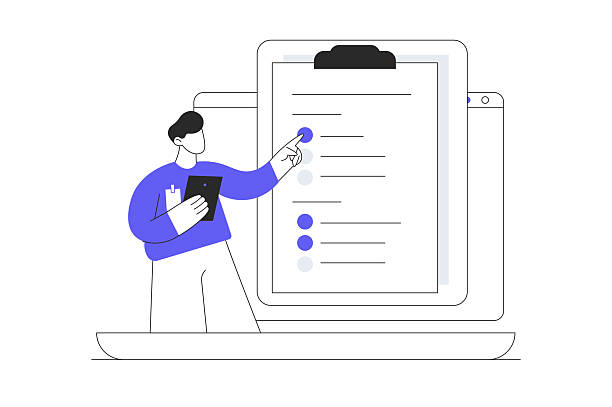
Even with the best intentions and initial knowledge, some common mistakes can nullify your efforts in SEO-optimized website design.
Identifying and avoiding these mistakes is essential for long-term success.
One of the most common errors is neglecting keyword research or performing it superficially.
Without appropriate keywords, your content cannot reach its target audience.
An educational point here is to dedicate enough time to this stage and use specialized tools.
Another mistake is producing low-quality or duplicate content.
Content that lacks added value, is copied, or is merely written to be stuffed with keywords will not only not help your SEO but can also lead to Google penalties.
Your content must be unique, comprehensive, and useful.
Neglecting user experience (UX) is also a major error.
Slow loading speed, lack of responsiveness, complex navigation, and intrusive pop-ups can all drive users away and harm your SEO ranking.
As a guidance, always evaluate your website from the user’s perspective and implement necessary improvements.
Spammy link building or purchasing low-quality backlinks is also a fatal mistake that can lead to manual or algorithmic penalties from Google.
Link building should be natural and based on the value of your content.
Not using optimized title tags and meta descriptions, or duplicating them across different pages, are other technical mistakes that negatively impact your SEO.
Each page should have a unique and engaging title and meta description that includes the main keywords of that page.
Lack of data monitoring and analysis is also a big mistake.
SEO is a continuous process, and without monitoring performance and analyzing data, you cannot identify problems and implement necessary improvements.
A thought-provoking question is whether sustainable success can be achieved solely by performing initial SEO? The answer is definitely no.
Search engines and user behavior are constantly changing, and your SEO strategy must also be flexible and dynamic.
By avoiding these mistakes and adopting a comprehensive approach, the path to success in SEO-optimized website design will be much smoother.
The Future of SEO and Website Design

The future of SEO and website design is more intertwined than ever, and understanding future trends is crucial for any business seeking online success.
One of the most important trends ahead is the increasing importance of user experience (UX) and Core Web Vitals.
Google constantly updates its algorithms to rank websites that provide the best user experience higher.
This means a greater emphasis on website loading speed, interactivity, and visual stability.
Voice search is also growing significantly.
With the increasing use of voice assistants like Siri, Google Assistant, and Alexa, optimizing for voice search SEO will become more important.
This type of search is usually longer, more conversational, and question-based, requiring a different approach to keyword research and content creation.
Artificial Intelligence (AI) and Machine Learning also play an increasing role in SEO.
Google’s algorithms like RankBrain and BERT use AI to better understand user intent and provide more accurate search results.
This means that your content must be genuinely useful and comprehensive, not just keyword-stuffed.
This analysis shows that focusing on quality and natural content is more important than ever.
Video content has also become increasingly popular and is expected to play a more prominent role in SEO in the future.
Optimizing videos for search (Video SEO) through the use of keywords in titles and descriptions, structuring data, and adding transcripts, can help attract more traffic.
Emphasis on Local SEO for physical businesses will also continue, as more users use mobile to find businesses near them.
Overall, the future of SEO and website design is moving towards creating websites that are not only understandable to search engines but also provide an excellent user experience, leverage AI, and respond quickly to technological changes.
This comprehensive approach will guarantee success in the future digital ecosystem.
Frequently Asked Questions
| Question | Answer |
|---|---|
| What is SEO-optimized website design? | Designing a website that is optimized for both users and search engines to achieve higher rankings. This includes adhering to technical, content, and user experience principles. |
| Why is SEO important in website design? | The importance of SEO in website design is due to its role in increasing site visibility in search results, attracting organic traffic, improving user experience, and enhancing user credibility and trust. |
| What are the most important elements of SEO-friendly website design? | Responsiveness for mobile, fast loading speed, clear navigation structure, correct use of heading tags (H1-H6), image optimization, and quality content. |
| What is the impact of responsiveness (mobile-friendliness) on SEO? | Google uses mobile-first indexing, meaning it prioritizes the mobile version of websites for ranking. Therefore, responsiveness is crucial for SEO. |
| What is the role of site speed in SEO? | Faster websites provide a better user experience, reduce bounce rates, and are favored by search engines. Site speed is one of Google’s ranking factors. |
| How do we optimize images for SEO? | By compressing image sizes, using descriptive and relevant file names, and most importantly, writing appropriate and content/keyword-relevant Alt Text. |
| What is the importance of content in SEO-driven design? | High-quality, relevant, and keyword-rich content is vital for engaging users and for ranking in search engines. Content is the king of SEO. |
| How does URL structure affect SEO? | Clean, descriptive, short URLs containing keywords help users and search engines better understand page content and appear in search results. |
| What is Schema Markup and what is its role in SEO? | Schema Markup is structured data that helps search engines better understand site content and display it as Rich Snippets in search results, which increases the click-through rate (CTR). |
| Should SEO be considered from the beginning of website design? | Yes, it is highly recommended. Integrating SEO principles from the initial phase of website design saves time and cost and leads to better and more sustainable long-term results. |
And other services by Rasa Web Advertising Agency in the field of advertising
Smart Data Analysis: A dedicated service for growth in customer acquisition based on attractive user interface design.
Smart Advertising Campaign: A combination of creativity and technology to increase click-through rates through custom programming.
Smart Data Analysis: A fast and efficient solution for increasing click-through rates with a focus on marketing automation.
Smart Digital Advertising: A novel service for increasing customer acquisition through the use of real data.
Smart Content Strategy: Professional optimization for increasing sales using intelligent data analysis.
And over hundreds of other services in the field of internet advertising, advertising consultation, and organizational solutions
Internet Advertising | Advertising Strategy | Advertorials
Sources
SEO-Optimized Website Design – IranHost
SEO-Optimized Website Design – Rayab
SEO Website Design for Success in Google – Webramz
What is SEO and What is its Application? – Pishgaman
? With Rasa Web Afarin Digital Marketing Agency’s services, see your business at the peak of competitiveness. From custom website design and SEO to targeted advertising campaigns, we offer comprehensive solutions for your growth and success. To learn more about our services and receive a consultation, contact the expert team at Rasa Web Afarin today and build your digital future.
📍 Tehran, Mirdamad Street, next to Bank Markazi, Southern Kazeroun Alley, Ramin Alley No. 6



